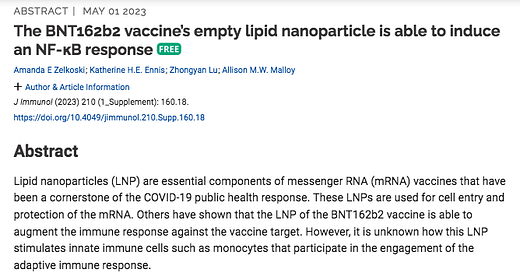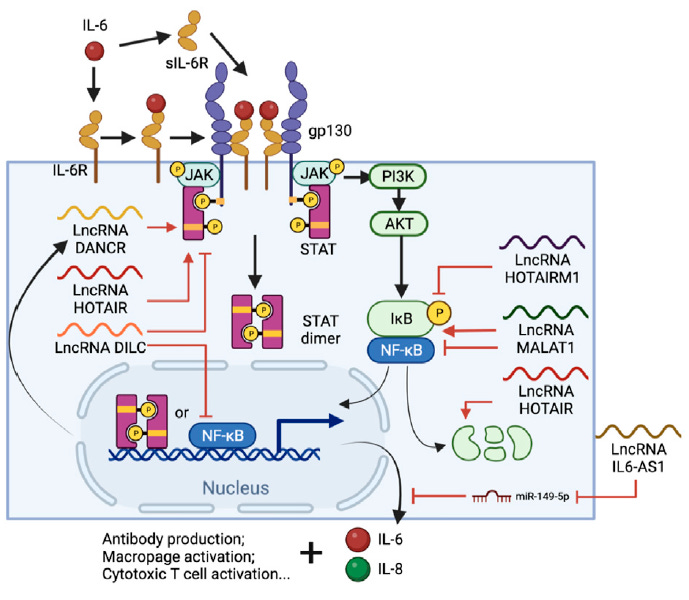Empty mRNA Jab LNPs are contaminated with Endotoxin that increases NF-κB
No mystery why Empty Lipid Nanoparticles cause stimulation of innate immune cells such as monocytes. US Defense tries to divert attention away from known pathways
Numerous entities have a desperate need to divert attention away from Endotoxin in Jabs, especially the ones using Lipid Nanoparticles to transfect your cells.1
One diversionary tactic is to blame the chemicals used in the present mRNA Covid19 Jabs, with the implication that perhaps redesign of the LNPs with new chemicals will fix the problem.
As Dr Robert Malone2 and others have pointed out (naming CIA agents), this is known as (Modified) Limited Hangout.3
In recent days there has been renewed interest in an Abstract on Empty LNPs published inMay 2023.4 It is free to download, however I was most disappointed that the resulting pdf is simply a rehash of the Abstract. So I have asked via X whether anyone has found an actual peer-reviewed paper.5
Here is what we can see:
This US Military Limited Hangout operation claims that the LNPs increases innate immune response of all Pfizer Process 2 Poojab recipients cells by increased expression of NF-κB independent of Interferon Regulatory Factor (IRF) activation. But it is nice of them to mention the Endotoxin (LPS) damage, so they can claim every Jabbee gave “Informed Consent” from May 2023.
I have previously reported that all of the chemicals Pfizer uses in its LNPs are contaminated with Endotoxin, negating the work of Zelkoski et al.6
The authors fail to mention the whole story that looks like this, as reported by honest Korean scientists Lee et al in October 2023.7
Those familiar with cell surface receptors will see immediately the Self-Amplification of Cytokine Storm can proceed by Endotoxin generated Interleukin 6 (IL-6) via its own receptor and the gp1308 pathway that directly increases NF-κB activity in your cell Nucleus to increase inflammation by exploding Chemokines (including IFN) and Cytokines.
The figure caption from Lee et al reads:
Fig. 1 TLR and RLR signaling pathways and the effects of LNPs.
A. TLRs include TLRs 3, 7, 8, and 9 on the endosome surface as well as the rest of the TLRs on the cell membrane surface. When a TLR recognizes a foreign antigen, downstream signals are activated, starting with the MyD88 adapter, except for TLR3. Transcription factors such as AP-1, NF-kB, CREB, c/EBP, and IRF3 ultimately migrate to the nucleus and initiate the innate immune response. When transcription factors are activated, cytokines, chemokines, and type 1 IFNs are activated, and innate immunity occurs. RNA is recognized by endosome TLRs 3, 7, 8, and 9, and LNPs encapsulated with mRNA can be recognized by the MyD88 adapter.
B. When foreign RNA is recognized by MDA5 and RIG-1, RNA helicases in the cytosol and by STING proteins on the surface of the endoplasmic reticulum, the RLR signaling pathway is activated. It activates the transcription factors NK-κB and IRF3 through MAVS, a signaling adapter protein, and promotes cytokines and type 1 IFNs. At this time, LNP can activate MDA5 to trigger immunity.
My friend DoorlessCarp just guided me to work on the self-amplification of IL-6 with upregulation of NK-κB via gp130 aka IL6ST, IL6R-beta or CD130 published in 2022 by researchers at the University of Sydney.9
Here is their Figure 3 which includes triggering of the JAK/STAT pathway and impacts of Long non-Coding RNA (LncRNA).
FIGURE 3
IL-6 signal cascade and regulatory lncRNA involved in the process. IL-6-bound IL-6R or sIL-6R forms complexes with membrane protein glycoprotein 130 (gp130), which triggers the JAK/STAT pathway and eventually leads to STAT3 phosphorylation and nuclear translocation. NF-κB is also activated via the (PI3K)-AKT pathway and, together with STAT3, promotes immune cell differentiation and IL-6, IL-8 expression.
Throughout the process, lncRNAs such as DANCR, HOTAIR, HOTAIRM1, DILC and MALAT1 are involved in either or both pathways by regulating STAT3 phosphorylation, NF-κB interacting with chromatin or the degradation of IκB. Meanwhile, IL-AS1 can regulate IL-6 expression by sponging miR-149-5p, thus protecting IL-6 mRNA.
So my guess is that the Abstract by Zelkoski et al. will never pass a proper peer-review but is still being used to divert attention.
Those interested in such sneakiness might examine networks and funding in US, Canada, Israel, France, Germany, UK and perhaps even Australia involved in this and other Limited Hangouts.
Lethal Implications for Covid19 and other Jabs
A friend just forwarded me an abstract of a paper10 published in 2000, funded by the U.S. Department of Veterans Affairs; the Parker B. Francis Foundation Fellowship in Pulmonary Research; the American Lung Association; and Grants HL07123 and HL61419, National Heart, Lung, and Blood Institute, National Institutes of Health.
Researchers were based in Vanderbilt University School of Medicine and Department of Veterans Affairs Medical Center, Nashville, Tennessee.
Here are some selected quotes:
We measured neutrophil accumulation in the alveolar spaces at 24 h after intraperitoneal LPS. At doses of intraperitoneal LPS that increased lung luciferase and maximized lung KC content (1 to 3 µg/g), neutrophil accumulation in the air spaces was found. However, a lower dose of intraperitoneal LPS (0.3 µg/g) did not result in neutrophilic influx into the alveolar space at 24 h, even though this dose of intraperitoneal LPS did cause increased NF-kB-dependent luciferase activity in the liver. This finding suggests that local NF-kB activation and inflammatory mediator production in the lungs may be required for subsequent neutrophilic alveolitis.
Recently, NF-kB activation has been implicated as an important factor in humans with acute respiratory distress syndrome (ARDS), which is characterized by neutrophilic lung inflammation and diffuse alveolar damage, and can result from systemic inflammation. Schwartz and colleagues (31) reported that NF-kB is activated in alveolar macrophages from patients with ARDS to a significantly higher degree than in alveolar macrophages from critically ill patients with other diseases.
In addition, NF-kB activation may be important in the pathogenesis of sepsis. Bohrer and colleagues (32) reported that in peripheral blood monocytes of patients with sepsis, NF-kB activation correlates with mortality.
Specifically, all patients in that study who died with sepsis had increased NF-kB activation (greater than twice baseline) in the first 6 d, whereas all patients who survived had NF-kB activation that remained less than twice the baseline value at each time point during the 14-d study period. These and other data suggest that the pathobiology of sepsis and ARDS is related to exuberant production of NF-kB-dependent proinflammatory molecules, leading to inflammatory cell influx, cell activation, and tissue injury in response to bacterial products such as LPS.
Huge impact creating numerous Diseases
Thanks to my friend in Germany NarfGB, who sent us a reference to a useful review.11
Their Figure 1 should be used by Jab manufacturers on their packages to obtain "Informed Consent" for the known and yet to be discovered effects of increasing their NF-κB with the Endotoxin present in every vile vial.
And my friend Bioanon reminded us of the Wikipedia entry12 that tells us that
HIV-1, activation of NF-κB may, at least in part, be involved in activation of the virus from a latent, inactive state
Please let me know what else you find.
Endotoxin Jabbing recommended by The Wellness Company ?
Hands up who believes repeated subcutaneous self-injection of QBECO “inactivated” Escherichia coli clinical isolate from a patient with Bloody Diarrhea will be a great therapy? Wellness Company owners are pushing it to the extent of Clinical Trials.
https://rumble.com/v1kysxb-dr.-robert-malone-politico-article-used-as-modified-limited-hangout-by-glob.html
https://en.wikipedia.org/wiki/Limited_hangout
Amanda E Zelkoski, Katherine H.E. Ennis, Zhongyan Lu, Allison M.W. Malloy. May 2023. https://journals.aai.org/jimmunol/article/210/1_Supplement/160.18/264826/The-BNT162b2-vaccine-s-empty-lipid-nanoparticle-is
LNPs Contaminated with Endotoxin?
Recently I updated my article on the Spike Protein derived from the Covid19 virus or the synthetic GMO Spike produced by the mRNA jabs to discuss a Zebrafish study by Zheng and coworkers that has been made invalid by Endotoxin contamination of commercial Spike.
Yeji Lee, Michaela Jeong, Jeongeun Park, Hyein Jung and Hyukjin Lee. October 2023. Immunogenicity of lipid nanoparticles and its impact on the efficacy of mRNA vaccines and therapeutics. https://www.ncbi.nlm.nih.gov/pmc/articles/PMC10618257/
https://en.wikipedia.org/wiki/Glycoprotein_130
Yichen Zhong, Caroline L. Ashley, Megan Steain and Sandro Fernandes Ataide. 2022. Assessing the suitability of long non-coding RNAs as therapeutic targets and biomarkers in SARS-CoV-2 infection. https://www.frontiersin.org/articles/10.3389/fmolb.2022.975322/full
Timothy S Blackwell, Fiona E Yull, Chih-Li Chen, Annapurna Venkatakrishnan, Thomas R Blackwell, Donna J Hicks, Lisa H Laancaster, John W Christman and Lawrence D Kerr. 2000. Multiorgan Nuclear Factor Kappa B Activation in a Transgenic Mouse Model of Systemic Inflammation. https://www.atsjournals.org/doi/full/10.1164/ajrccm.162.3.9906129
Ting Liu, Lingyun Zhang, Donghyun Joo and Shao-Cong Sun. 2017. NF-κB signaling in inflammation. https://www.nature.com/articles/sigtrans201723
https://en.wikipedia.org/wiki/NF-%CE%BAB









Dr. Bruce Patterson has linked infected monocytes to ARDS and post acute Covid syndrome. Your model of NFKB explosion leading to ARDS, can also be made for CCR5 cytokine explosion in AIDS, that’s why the Delta-32 mutation prevents AIDS!
Rest assured that repeated sub cu shots of purified poop (!) will go exactly where they are supposed to and do exactly what they are told to do, because brilliant experts have a great track record with magic shots. I surmise this is the next step after fecal bacterial transplants for repopulating the intestinal biome. Did you ever hear how that worked out?